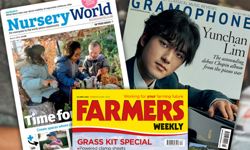
In 1958, McGraw Hill ran an ad promoting their magazines as effective business advertising tools. The full-page spread showed a grumpy looking manager sitting in his office chair, hands clasped in front of him, glaring at the reader.
The ad read:
"I don’t know who you are.
I don’t know your company.
I don’t know your company’s product.
I don’t know what your company stands for.
I don’t know your company’s customers.
I don’t know your company’s record.
I don’t know your company’s reputation.
Now – what was it you wanted to sell me?"
Imagine confronting this sort of wary and begrudging prospect when you write your next subscription promotion, and chances are the end result will be massively improved by the exercise. Simply because you have tried to put yourself squarely in your prospect’s recalcitrant shoes.
It’s very tempting not to do this, and to rely on the assumption that your prospect knows, likes and wants your magazine. All you really have to do is shout "come and get it", and the orders will flow in… right? As for any promises you might make about your title – claims about the benefits it offers – why, your audience will simply take them on faith.
Like hell they will. They’ll be about as unquestioning as a VAT inspector with inflamed sinuses and chronic gout.
"You want me to believe you? Then PROVE it."
Coming as I do from the hard-knock school of copywriting, I’ve picked up a few techniques along the way that can help you instil an unswerving conviction in your prospects that everything wonderful you claim for your magazine is true.
Up to now, you may well have been content to rely on that rather hackneyed copy ploy: "But why believe everything we’ve told you? Ask for a free trial copy of Mechanical Digger and see for yourself." You may also have tossed in a few testimonials from satisfied readers, for good measure.
That’s all very well, as far as it goes. But you can be a lot more creative when it comes to giving your copy ‘instant credibility’. Here are just a few ideas to help you write powerful and persuasive copy for the Doubting Thomases and Thomasinas of this world:
1. Offer third-party proof.
Don’t get me wrong, I’m a big fan of testimonials. Hard-working ones, that is – quotes from readers who share the specific benefits they have gained from your magazine. Even better are pats on the back from famous people, or people well-respected in a field related to your subject matter. If you don’t know any ‘stars’, then here’s another idea: consider suggesting an endorsement from someone who matters to your prospect. For example, when I was creating a mailing for Junior magazine, I decided to infer approval with the following outer envelope message: "Discover the parenting magazine your children would choose. (Naturally, they want you to have the very best!)"
2. Mention your glittering prizes.
If you’ve picked up some awards lately (and I mean awards for your editorial excellence, not for your ability to flog magazines successfully), then by all means include them… accompanying each one with the appropriate logo. Haven’t collected any gongs lately? Then what about including the results of a customer satisfaction survey, or a favourable newspaper clipping about your magazine? Hopefully you can see what’s at work here. If august institutions respect your title, then naturally you’re not the sort of magazine that would stoop to empty promises.
3. Don’t hide your pedigree.
When I was researching a project for the Times Literary Supplement, I was astonished to learn how many famous authors had contributed to its pages since it began life in 1902. What more natural thing to do than to list these contributors on the outer envelope of the subscription mailing, giving additional emphasis to the journal’s history inside. If your particular title hasn’t been around quite so long, you might instead be able to use the status of your editor to good effect (think Boris Johnson or Ian Hislop), or run the names of your illustrious editorial board down the left-hand column of your letter. You might also make a big play of the fact that your magazine was the first in its market, should that be the case.
4. Employ a ‘disclaimer’.
Once you’ve sold your prospects on how many rewarding ways your magazine will improve their lives, you can add credibility to your claims by making a hand-on-your-heart disclaimer. To whit: "We don’t promise that Bon Appétit will turn you into a celebrity chef. What we do promise is this: by following the recipes and techniques in every issue, you’ll find it easier to turn out really delicious meals time after time – whether you’re cooking for two or for ten." Now that really does have the ring of truth!
5. Suggest widespread or growing popularity.
If your circulation is growing by leaps or bounds, or your magazine is more widely read than any of your competitors, for goodness’ sake, say so. Your prospects will assume that that many people simply can’t be wrong… and that neither, by extension, can the enticing benefits you’ve described.
6. Sell the little dream instead of the big dream.
This technique was a favourite of my mentor in Manhattan, Tom Collins. Tom reckoned that so many promotions promise the fulfilment of a ‘big dream’ (overnight wealth, instant weight loss) that maybe a ‘little dream’ would prove more believable and therefore attractive. What that dream might be for your readers, I have no way of knowing. But to give you an example, a financial journal might promise that readers will "get rich slowly", thanks to the astute investment advice the publication provides.
7. Don’t neglect the ‘mechanics’ of satisfaction.
Your prospects need to be satisfied that your product will deliver. But they also need to be convinced about the ‘mechanics of satisfaction’ you’re offering – your offer, terms and money-back guarantee, for example. Remember, you’re writing for a sceptical audience, so if you can substantiate your amazing discount, great. (Are you being as generous as you are because you’re writing to someone whose stature in a particular industry makes them a ‘must have’ reader, for instance?) And what about your tired old guarantee? Don’t treat it like a poor relative – it’s one of the most credibility-boosting tools you have in your copy arsenal.
You might also consider adding a question-and-answer section to your control, explaining the various aspects of your service proposition in a single, dedicated place.Qs & As made their first appearance in financial direct marketing promotions… and you know how hard it is to get people to switch banks!
8. Harness the power of disinterest.
Obviously you want everyone who reads your subscription promotion to say, "yes, I’ll take it." So, why in heaven’s name would I suggest that you tell your prospects that your magazine might not be right for them? Because I want you to be believed, 101%, that’s why. Here is an example of what I mean by "disinterested" copy: "Frankly, it wouldn’t make a lot of sense for you to subscribe to Horse & Rider if riding is just an occasional pastime for you. But if you’re serious about your sport, and want to keep raising your skills hurdles, then you won’t find better support, advice and encouragement from any other source."
9. Demonstrate your magazine’s effectiveness.
Can you directly prove that your magazine delivers on its key promises, by citing a persuasive statistic? For example, have a substantial number of your readers gained a promotion in the last few years? Have they featured amongst the great and the good on various executive boards? You have to be careful here, because your magazine hasn’t – obviously – played an unquestioned role in these achievements. But a little artful inference can nevertheless go a long way!
10. Give a rationale for your deadline.
Back to that grumpy manager in the McGraw Hill ad. Do you think for one moment that he would scamper to meet your reply-by deadline just because you’ve told him he has to? No way. He’s going to want to know why he has to act now. Could it be that yours is a launch communication and you are offering a free trial issue? In this instance, it would make perfect sense to tell your prospect that he or she would be wise to hurry, as demand will be great and you don’t want to cause any disappointment.
11. Give it away.
While we’re on the subject of free-trial offers, have you ever wondered why they work – aside from the obvious reason that it’s natural to want something for nothing? I think one reason is because they demonstrate supreme confidence in the magazine being advertised. After all, what publisher is going to part with expensive free issues if they aren’t going to measure up, in the flesh, to all of the claims made for them in the ad copy?
12. Position your magazine as a service.
If someone asked me what I think the most important characteristic of good advertising copy is, I would say that it’s the ability to honestly and convincingly demonstrate to a reader that you are offering a service that will prove absolutely invaluable to his or her life… and not merely flogging a product.
Now, how many of you can honestly tell me that’s what your current subscription copy is doing?











